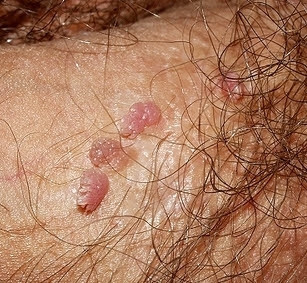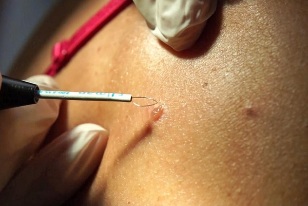
More often than not, people don't suspect that they have human papillomavirus (HPV) in their bodies. This is due to the fact that papillomavirus are usually present in a latent form, suppressed by natural immunity. Problems arise when it gets out of control and begins to actively manifest itself in the form of growths in different parts of the body. Men are less likely to suffer from viral effects than women, but for them, the action can turn into a serious problem in the form of papilloma on the penis.
Causes of occurrence
Viral DNA enters the body through micro-gaps in the skin or mucous membranes. If a man's immunity is weakened, the first manifestations of HPV will appear several months after infection.
Up to 80% of transmission occurs via sexual channels. Barrier contraception minimizes the risk of infection, but does not completely eliminate it.
Other ways of infection:
- Household path.The virus is shared with the infected person's personal belongings: clothes, cleaning supplies, etc. The risk of transmission is increased if the skin is damaged, even small. This pathway is characterized by low oncogenic viral strain infection. They don't cause serious health problems, but appear in the form of genital warts, papillomas and warts, which cause cosmetic defects.
- Mother to child.If the mother becomes infected with HPV during pregnancy and childbirth and gives birth naturally, it is highly likely that the baby will become infected.
If a man has good immune defense, the virus does not manifest itself and can remain in the body for a long time in a latent form. Therefore, it is not the viral infection itself that is dangerous, but weakens the immune system, leading to the activation of HPV.
There are a number of factors that influence the possibility of strengthening the position of the virus:
- chronic disease;
- hormonal problems;
- either chose contraception or did not exist;
- virus infection;
- alcohol, smoking, or long-term use of antibiotics;
- is often stressed.
All of these factors have a negative impact on the immune system. If in a man's life there is not one provoking factor, but several, this will lead to more rapid development of the papillomavirus.
Symptoms
Often, papillomas appear only externally, however, in some cases, nonspecificsymptoms can occur:
- itching and burning during intercourse;
- pain when touching the papilloma;
- accumulation of urine in the folds of the penis;
- unpleasant odor in the affected area.
In addition, neoplasms can grow and affect not only the penis area, but also appear on the anus and pubis.

What do papillomas look like
Penile papilloma is a small neoplasm. At first, it may present itself, but without proper treatment, the number of papillomas increases. However, the two of them can join each other.
This growth looks like a flesh-colored or pink cauliflower. Most often they are localized on the foreskin, head and frenum. Less often, they are diagnosed in the urethra and scrotum. Papillomas can also appear as tiny white pimples that appear in long rows. This shape is typical for localization in the bridle area.
One of the manifestations of HPV is Buschke-Levenshtein warts. It is distinguished by its fast growth, excellent size and resistance to various types of treatment. It is caused by several existing papillomas and warts, which join together to form one large area of the lesion. The presence of Buschke-Levenshtein condyloma is dangerous because the cells converted by it can easily develop into cancer.
Which doctor to contact
Typically, urologists treat the diagnosis of papilloma in men. You can also seek advice from a dermatologist or proctologist if you have genital warts on the anal area. However, papillomas are usually referred to a surgeon for removal. In total, the diagnosis occurs in several stages:
- Urologists examine and interview patients.Verbal questions are needed to assess the patient's lifestyle and determine the cause of viral infection. Visual examination involves assessing not only the condition of the penis, but also adjacent organs - the scrotum, the anal area. This is necessary to complete the picture of virus localization.
- Urethral swab.Determine the presence of various sexually transmitted diseases.
- PCR.This analysis shows not only the presence of HPV in the body, but also most likely determining its type.
- Meatoscopy.This procedure is an examination of the urethra if the papillomavirus has infected the frenum.
- After the removal of thepapilloma, the doctor may order a biopsyto assess the condition of the tumor being removed. This is necessary to eliminate the risk of developing cancer and to ensure that the papilloma is benign.
In this case, we recommend conducting a survey of both partners. Usually a woman is also infected with one type of papillomavirus. If only a man is being treated, he will likely get sick again after a while.
Why are papillomas dangerous?
Human papillomavirus is often accompanied by other related diseases. The appearance of papillomas in the glandular area of the penis contributes to the accumulation of urine in the folds. This creates the conditions for the appearance and growth of various microorganisms, which then cause infection. They can trigger erosions around the papilloma, and also contribute to inflammation of the urethra and testicles. This disease is characterized by problems urinating, pain and high fever.
Another danger is trauma to the neoplasm, which causes bleeding. This is due to the fact that many blood vessels are formed around the papilloma, which supply them with blood. Even minor damage can lead to infection from injury.
In addition, neoplasms can rub together while moving, causing pain and discomfort for men.
HPV and cancer
When new viruses start to spread, neoplasms are sporadic and benign. Without treatment, they grow and merge with each other. Over time, the cells degenerate into malignant cells.The risk of cancer is very high especially if a man is infected with a very oncogenic strain of the virus - 16 or 18.They are the ones who contribute to the development of cancer of the penis and bladder.
Papilloma treatment
HPV treatment not only eliminates its external manifestations, but also strengthens the immune system, which should block viral manifestations.Immunostimulant drugs are used to maintain immunity.
As an antiviral drug, an ointment that suppresses viral propagation and removes small growths is effective. It does not always cope with the task of total displacement, but prevents the emergence of new growth. Antiviral ointments are prescribed to stimulate immunity. Ointment does not get rid of papillomas, but increases the activation of cells of the immune system, which stops their growth and development.

Removal method
There are several ways to get rid of the new growth that has emerged:
- Laser removal.Papillomas are exposed to laser light, which literally burns the growths. A crust forms in this place, which subsides after a few weeks. The method is considered effective because there is no recurrence. The removal is carried out under anesthesia. No bleeding, no scars or scars.
- Cryodestruction.Papillomas are exposed to liquid nitrogen. It instantly freezes the desired area, the neoplasm on it collapses and dies. The disadvantage of this method is the inability to control the depth of the cryodestruction effect. At the site of the removed papilloma, a crust is also left, which disappears after a while.
- Radiosurgery.The principle of this method is similar to laser removal. Radio waves leave no scars and scars, and the procedure is initiated under initial anesthesia with a special spray. After that there were no complications, and the body quickly recovered.
- Electrocoagulation.This growth is affected by an electric current, which causes the leg to be lifted, after which the papilloma disappears. Superficial anesthesia can be given if necessary. This procedure takes several minutes, is widespread and affordable. However, this method is able to leave scars after healing.
- Surgical intervention.It is used in rare cases when the tumor becomes too large. It is carried out under anesthesia, has a long healing and trauma. The method is good because it allows you to save the removed growths for histological examination.
The cost of each method depends on the complexity of the job, the size and number of papillomas to be removed.
Before choosing a method, consult your doctor. He will tell you what is best to use in your situation, tell you in detail how the procedure was performed. Also, after removal of the neoplasm, it is advisable to take materials for histology. This is necessary to determine whether the degeneration process of benign neoplasms to become malignant has begun. This method will help detect cell changes early and prevent the spread of cancer.














































































